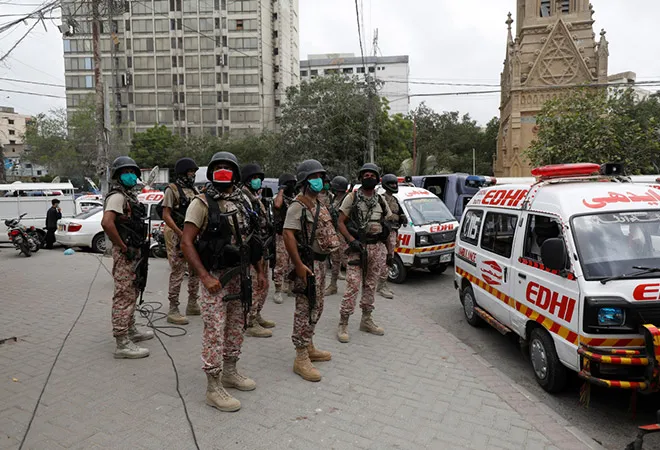
The attack on the Pakistan Stock Exchange (PSX) in Karachi on June 29 by four gunmen carrying assault rifles and grenades fizzled out before any major damage could be caused. All the attackers were neutralised before they could storm into the building of the stock exchange. A Pakistani official has claimed that the entire attack was over in just around 8-10 minutes. As is their wont, the Pakistanis were quick to point fingers at India, so quick that within minutes of the attack, and even before the identity of the attackers or their affiliation was known, the Pakistanis – spooks, soldiers, scribes and of course politicians – had figured it all out. Clearly in Pakistan, with innuendo being the new investigation, the judgment pronounced in less than an hour after the attack.
The first off the block was the Karachi chief of Pakistan Rangers. Pakistan's very own Sherlock declared that the involvement of the Indian intelligence agency R&AW could not be ruled out because “such attacks are not ‘stand-alone incidents’ and cannot take place without the aid of ‘outside intelligence agencies’”. With the Pakistan military having given the cue, it wasn’t long before the entire theatre jumped in to accuse India of masterminding the attack. Starting with Imran Khan’s sidekick on security and strategic policy who tweeted his accusation, it went up the chain with the foreign minister hinting at India’s involvement, followed by the Prime Minister himself holding forth in Pakistan's National Assembly and saying he had “no doubt” that India was behind the attack.
The Indian Ministry of External Affairs was quick to hit back, and rejected the “absurd comments” of the Pakistani foreign minister who was trying to shift the blame on India for Pakistan's domestic problems. India was bound to be incensed over the utterly malicious allegations which were backed by no evidence. But what was even more galling for India was the fact that Pakistan's accusations were seen as an affront to the competence of Indian security agencies. If anything, the sheer incompetence of the attackers, their lack of training and their unprofessional tactics are the biggest proof that India had nothing to do with it. Surely, if the attackers had been trained by Indian agencies, like the 26/11 attackers were trained by Pakistan military, the result would have been very different.
The CCTV footage of the attack stands testimony to the fact that the attackers were unprepared, untrained and unfamiliar with even the basics of launching such an attack. Any professional would have first done a proper reconnaissance of the target, factored in the drills and security of the place, worked out a proper attack plan, and of course figured how to cause maximum damage and make a big splash. None of this was evident in the way the attackers approached the target and launched the attack. It was almost as if they were reluctant, hesitant, and unsure of what they had to do. It was almost as if a couple of guys had been sent in to just get killed – lambs to the slaughter. And this raises some questions about the purpose of the attack, and that of the masterminds. It also raises questions about the organisation – Balochistan Liberation Army (BLA) – that is supposed to have claimed responsibility for the attack Telegram channel is still active>.
Assuming it was indeed the BLA, then it reflects quite poorly on an organisation that was not so long back in the vanguard of the insurgencies being fought in Balochistan since the 1970s. The fifth insurgency in Balochistan that started around 2001 and gathered pace after the murder of Nawab Akbar Bugti by the Pakistan Army in 2006 has been spearheaded by the BLA along with Balochistan Liberation Front (BLF) and a few other outfits. But over a period of time, a number of factors have whittled down the potency of some of these organisations. These include a brutal crackdown by the Pakistan Army, the lack of any external support which has in turn translated in a severe shortage of funds for equipping the freedom fighters associated with these groups, the lack of training and the unkindest cut of all, the designation of the BLA as a terrorist organisation by the US in 2019. In fact, the Baloch independence struggle has been a victim of Great Power politics in the region because the first big blow to the BLA was struck by the US-led NATO forces in Afghanistan who are believed to have taken out the charismatic BLA chief, Nawabzada Balach Marri, in an airstrike inside Afghanistan in 2007. It is believed that Balach had been eliminated as a gift aimed at getting the Pakistanis to deliver on Taliban.
Since the BLA had been led by the Marri tribe, after Balach his brothers Mehran and Hyrbyar are supposed to have taken the reins of the organisation. But both these brothers were more politicians and diplomats than fighters. Unlike Balach who was fighting on the ground against the Pakistani state, his brothers guided the BLA from their perch in Geneva and London. The death of the legendary Nawaz Khair Bux Marri in 2014 was another big blow, more so because of the infighting in the family to succeed the deceased Nawab. The pressure put by the Pakistanis on the Swiss, UAE and British authorities bottled up the Marri brothers who were worried that they might be deported/extradited to Pakistan.
It was under these circumstances that the BLA’s command went into the hands of the fighters on the ground. By all accounts it appears the tribal aristocracy no longer calls the shots in BLA. They may still command some respect, even influence, but no longer command the fighters. The good thing about this transition in leadership is that the movement is now no longer the armed wing of one tribe or one family but is more rooted to the ground, middle class based, and fanatically committed to the cause; the flip side is that it is not well resources, well organised, or even well-led and has made mistakes that have proved very expensive in terms of public perception and even support.
One of these factions that emerged in recent years is the Majeed brigade which is believed to be responsible for the last four big attacks – all of which failed in making any big splash. The group was led by Aslam Baloch aka Achu who was killed in a suicide bombing attack in Kandahar in 2018. The Kandahar attack happened just weeks after gunmen targeted the Chinese consulate in Karachi. Earlier the same group had claimed responsibility for the attack on a luxury hotel in Gwadar, and followed that attack by attempting to bomb a bus carrying Chinese engineers in the Dalbandin area of Balochistan. Given the target selection, it is being argued that this BLA faction has remained focused on Chinese targets because even the PSX has a substantial Chinese investment and the Chinese control the management of the exchange. But what is quite surprising is that despite repeated attempts, somehow the BLA faction always fails to cause any damage. While this raises serious questions about the capacity of the BLA, it also indicates the absence of any kind of professional help, or for that matter external assistance, available to this faction. Most importantly, it raises a serious possibility that the attacks being attributed to and claimed by BLA are in fact false flag attacks conducted by the Pakistanis for political, security, diplomatic objectives?
The timing of the attacks and the alacrity with which the Pakistanis blamed India without a shred of evidence certainly raises eyebrows. The PSX attack has come at a time when the Imran Khan government is in serious trouble. The coalition partners are very restive, and one has already deserted the coalition. The massive spike in petroleum prices has caused a major uproar. Even the journalists who functioned as mouth pieces of the regime have started expressing their disenchantment. The economy shows no sign of revival and is continuing to slide. The fiasco over the banning of PIA flights by virtually every important country has also dealt a huge blow. The sheer incompetence of the government and the continuing drift in affairs of state is so breathtaking that even the ‘selectors’ – Pakistan Army – are now reported to be really getting concerned over the flak they are receiving over their selection. Meanwhile, the Pakistanis are trying to side up to the Chinese, revive the CPEC project and even making common cause with them against India.
In such a situation, a high-profile terrorist attack which is snuffed out with minimal collateral damage serves multiple objectives. First, it diverts attention from the crisis ridden government – it is of course a different matter that given the scale and series of disasters that Imran Khan is visiting on Pakistan, these diversionary tactics wouldn’t have much shelf life. Second, it gave the Imran Khan government a reason to once again burnish their credentials with the military by going hysterical in their anti-India rants. Third, at a time when the US is once again naming Pakistan as a safe haven for terrorists, Pakistan gets to conveniently project itself as a ‘victim’ of terrorism. Fourth, it serves the purpose of showing to the Chinese how the Indians are targeting both ‘Iron Brothers’ and why they should collaborate to cut India to size. Fifth, it serves as a sort of casus belli in case the Pakistanis want to take some offensive action against India, most likely in conjunction with their ‘Iron Brother’.
Clearly, the Pakistani state is devious enough, deviant enough and desperate enough to carry out such attacks. If indeed this is the case, then it is a no-brainer that the truth will never come out and all ‘evidence’ will point in the direction of BLA and by extension, howsoever convoluted that might be, to India. On the other hand, if the BLA was actually involved, then it is quite apparent that the organisation just doesn’t have the skill set or the resources to carry through a spectacle of a terror attack. The Baloch might have the passion and drive to fight for their independence, but without external help, internal support systems and a wise leadership, the freedom movement is going nowhere.
The views expressed above belong to the author(s). ORF research and analyses now available on Telegram! Click here to access our curated content — blogs, longforms and interviews.




 PREV
PREV


